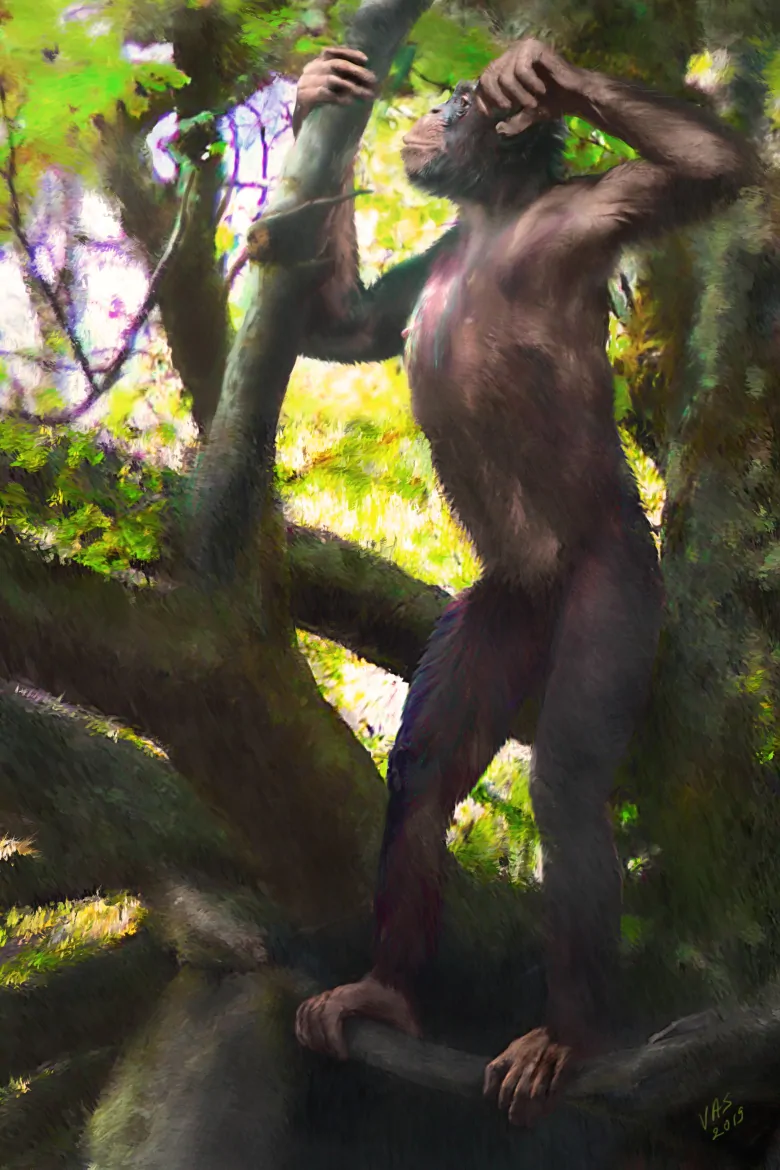Earliest ape adapted to walk upright found in Germany

The remains of an ancient ape found in a Bavarian clay pit suggest that humans’ ancestors began standing upright millions of years earlier than previously thought, scientists said Wednesday.
An international team of researchers says the fossilized partial skeleton of a male ape that lived almost 12 million years ago in the humid forests of what is now southern Germany bears a striking resemblance to modern human bones. In a paper published by the journal Nature, they concluded that the previously unknown species — named Danuvius guggenmosi — could walk on two legs but also climb like an ape.
The findings “raise fundamental questions about our previous understanding of the evolution of the great apes and humans,” said Madelaine Boehme, of the University of Tübingen, Germany, who led the research.
The question of when apes evolved bipedal motion has fascinated scientists since Charles Darwin first argued that they were the ancestors of humans. Previous fossil records of apes with an upright gait — found in Crete and Kenya — dated only as far back as six million years ago.

Boehme, along with researchers from Bulgaria, Germany, Canada and the United States, examined more than 15,000 bones recovered from a trove of archeological remains known as the Hammerschmiede, or Hammer Smithy, about 70 kilometres west of the Germany city of Munich.
Among the remains they were able to piece together were primate fossils belonging to four individuals that lived 11.62 million years ago. The most complete, an adult male, likely stood about 1 metre (3 feet, 4 inches) tall, weighed 31 kilograms (68 pounds) and looked similar to modern-day bonobos, a species of chimpanzee.
“It was astonishing for us to realize how similar certain bones are to humans, as opposed to great apes,” Boehme said.
This changes our view of early human evolution, which is that it all happened in Africa.– Madeleine Boehme, University of Tübingen
Thanks to several well-preserved bones, the scientists were able to reconstruct how Danuvius moved, concluding that, while it would have been able to hang from branches by his arms, it could also straighten his legs to walk upright.
“This changes our view of early human evolution, which is that it all happened in Africa,” Boehme told The Associated Press in an interview.
Previous theories wrong
David Begun, a University of Toronto paleoanthropologist who co-authored the study, said before Boehme found the bones of Danuvius, there were two main theories about how humans came to walk upright:
- Both apes, which walk on their knuckles, and humans, which walk upright, diverged from a common ancestor that moved like a monkey.
- Apes’ knuckle-walking was an intermediate step between humans and monkeys.
What Danuvius shows is neither of those theories is correct, because it has both the long arms that allow apes to walk on their knuckles— but also specific adaptations for walking upright: “Danuvius had some of those adaptations that we don’t see in living apes.”

Unlike humans, though, Danuvius had a powerful, opposable big toe that would have allowed it to grab branches with its foot and safely walk through the treetops.
While many people think of Africa as the cradle of humanity, Begun has been studying ape fossils in Europe since 1981. He said hundreds of fossils have been found from a dozen species of apes that lived from about 12 million to 7 million years ago, in countries like Spain, France, Germany and Hungary, which were covered in subtropical forest at the time.
Not only do they show the first adaptations for walking upright, but the development of big brains and human-like teeth adapted for eating harder foods on the ground instead of soft fruits in the trees. In fact, he thinks a previous hominin he discovered with Boehme that lived 7.2 million years ago may have been an early human.
“Europe was the place where really important things were happening that form the basis for what we are today.”
Fred Spoor, a paleontologist at the Natural History Museum in London, said the fossil finds were exciting but would likely be the subject of much debate, not least because it could challenge many existing ideas about evolution.
“This is fantastic material,” said Spoor, who wasn’t involved in the study. “There undoubtedly will be a lot for people to analyze.”





